Help IDing a Sansevieria (S. grandis or masoniana?)
Hi,
I was wondering if I could get some help IDing a new sans in my home. I repotted a really cramped plant that had been in about a 4" pot (no drainage!) for at least over 5 years, and took a couple divisions for myself. In the original pot it had a cluster of 3 leaves, and 2 separate ones from an offshoot of the rhizome (which are what I took).
After doing some research, I feel like I've narrowed it down to masoniana or grandis. From what I've read they are quite similar, and I'm hoping there's more to identify them than just the mature size. I'll include a couple pics, but it's about 2.5" wide, 9" tall, very matte and tough leaves, with a really beautiful golden margin/edge. All the leaves on the original plant were similar, but as I said, it was pretty restrained for a very long time.
Thanks for any advice! -Dan
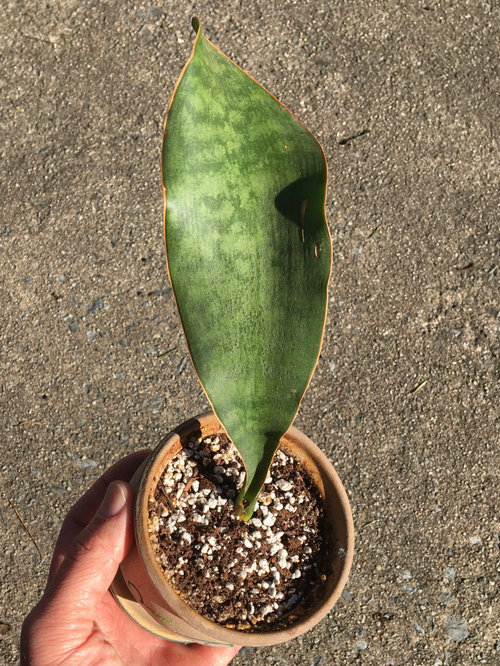

Comments (32)
Russ1023 (central Fla)
3 years agolast modified: 3 years agoDan, you could be right that this is grandis or masoniana. Your example in the pics looks shorter and wider than 2.5 by 9 inches. I think I understand that the parent plant of this offset had 3 leaves. Grandis typically has 4 to 5 leaves to a growth according to Juan Chahinian in his book The Splendid Sansevieria, mine usually have 3 or more. Masoniana normally has only 1 to 2 to a growth.
Your plant is randomly mottled which is consistent with masoniana. Grandis is mottled but the light green spots usually line up to form a loose horizontal banded pattern.
You mentioned the original plant being in a 4" pot for over 5 years, I would think if it was either of the two proposed species they would have busted out of the pot with huge offsets years ago. I guess it's possible if they were kept extremely dry they could have been held back, but for 5 years.... it doesn't seem likely. .
Where did you get this sans? A local store, a collector, online sale??? Is the original, older plant larger than this one?
I'll check my resources to see if your sans could be other species, and will check if I have a grandis and masoniana worthy of photos for your comparison.
Dan thanked Russ1023 (central Fla)Dan
Original Author3 years agoHi Russ; thanks for the thoughtful reply.
The original belonged to a friend who had it sitting in a store for decoration for years. It was actually planted in an old coffee mug, so I recently offered to pot it up for him to see if it would appreciate a little breathing room. There were originally 5 leaves total in the mug, but when I removed it, I found that 3 were clearly clustered, with 2 others distinctly separate on the short rhizome (those are the two I separated and kept). All the leaves were approximately the same size; if they were bigger on the parent section, it wasn't by much. It's definitely possible that it was kept very, very dry, but I couldn't say for sure.
I just double checked my plant, and it really is about 2.5" wide and 9" tall. They're remarkably tough and have a dry matte, almost rough, texture. "Leathery" is an understatement. It's hard to see, but the other specimen might have a little more of the banded pattern you describe. I'll attach a pic of my other one here.
From what I've seen in photos, it doesn't seem like Masoniana need a lot of space in a pot to grow large. That's what confuses me about this one, and led me to think maybe Grandis. Is there any chance it will suddenly take off in growth now that it has a little more room (and if I promise to give it a little bit of water now and then)? Or could I have a dwarf whale fin (sounds like an oxymoron along the lines of "jumbo shrimp"!)? Or something else?
Thanks again, Dan
Related Professionals
Mitchellville Landscape Architects & Landscape Designers · Gainesville Landscape Contractors · National City Landscape Contractors · Oxnard Landscape Contractors · Decatur Window Contractors · Palm Springs Landscape Architects & Landscape Designers · Madera Landscape Contractors · Middletown Landscape Contractors · Oviedo Landscape Contractors · Arkansas City General Contractors · Huntley Carpenters · Maple Valley Landscape Architects & Landscape Designers · Wrentham Landscape Architects & Landscape Designers · Salisbury Landscape Architects & Landscape Designers · Euclid Landscape ContractorsRuss1023 (central Fla)
3 years agoDan, here is a small masoniana in a 6" pot. If you get a new leaf, check the base of the petiole, if it has this reddish coloration in my 2nd pic, it confirms it is masoniana. Only two other sans has it, neither of which is grandis. Did you notice this on any plants when separating them?
I'm still looking for a grandis. Too many sans!!

Dan
Original Author3 years agoI can’t say I noticed any purple, but I wasn’t really looking either. I’m tempted now to dig in a little to have a peek...
Russ1023 (central Fla)
3 years agolast modified: 3 years agoDo that, it won't hurt anything. I'm curious too, but if it's not there it doesn't mean it's not masoniana, only that those leaves are older. The color typically fades after a short time.
Dan thanked Russ1023 (central Fla)Dan
Original Author3 years agoI loosened and pulled one out a bit to look at the base. No purple, just some tan sheath. Does that rule out Masoniana, and confirm Grandis?
-Dan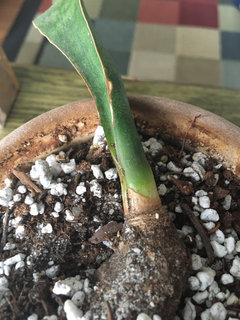
Dan
Original Author3 years agoEdit: sorry, just just looked back on your last statement, Russ. This growth is definitely not very new, so I guess the jury is still out.
Stush2049 Pitts. PA, zone 6
3 years agoRuss is the best here for ID's.
To add to this, My guess is on the Grandis side. Could be others out there as well but not Masoniana. My reason is all the masoniana I owned were root monsters. Like growing sweet potatos. Known pot breakers. Some times more root than leaf above growing. Plus to add the possibility of Grandis hybrid.
Norma Lewis told me once to never try to ID a Sans from a picture. Just too hard even for the experts. But most Sans today are easy to ID, this one not so easy.
Dan thanked Stush2049 Pitts. PA, zone 6Dan
Original Author3 years agoThanks everyone for the help with the ID; I'm happy to have found this forum.
I've had a number of houseplants for years, but only recently thought I might be on the verge of being a "collector". After digging a little deeper trying to identify this guy, I really appreciate how cool and diverse the Sansevieria genus is.
Might be a long shot, but.... since I have 2 of these plants that are likely grandis, is there anyone out there that would be interested in trading a masoniana for one of them? It's probably the wrong season (I'm in PA), but thought I'd ask and maybe we can figure it out. I love the idea of plant swapping, especially with prices these days, but unfortunately I don't have any local plant buddies.
Thanks again, DanRuss1023 (central Fla)
3 years agolast modified: 3 years agoThanks Stush! You're not kidding that masoniana has huge rhizomes, they can be over 4 inches thick. As big around as my wrist. But it's strange that any sans other than a dwarf would stay in a 4 inch pot for 5 years without new offsets pushing the whole thing up out of the pot.
Wise remarks from dear Norma, photo ID is very hard unless it's a common type with distinctive character.
Dan, I probably have an extra masoniana, email me at bluesea14808@yahoo.com and I'll see what I can do for you. It would be great if you become a sans collector and spread the word about these amazing, fascinating plants. There are literally hundreds of species, hybrids and varieties, most people only know of maybe a dozen or less. Most sans are very easy to grow and propagate.
You should turn on your Messaging so others can contact you for possible trades in the future.
Dan thanked Russ1023 (central Fla)Dan
Original Author3 years agoThanks! I think I have my messaging enabled now. I wish I had more plants of value, but I'm all about trades, so I'll keep a lookout and am always open to it.
(Russ, I'll send you an email as well)Stush2049 Pitts. PA, zone 6
3 years agoDan, I'm in PA myself and Russ was one of many here who took care of me. You sound like me 10 years ago. Come spring I'm thinning out my stock and message me your info for some plants.
Russ, your one of the Great Ones here. Thanks for sticking around.
Dan thanked Stush2049 Pitts. PA, zone 6Russ1023 (central Fla)
3 years agolast modified: 3 years agoThanks again Stush, you're a wealth of information here too. You have a lot of experience from 10 years of growing. It's hard to keep interest up during the winter, but the down time does give more opportunity to look at the forums and answer questions. I've had a long stretch of un-Florida like cool weather, no hard freezes yet though so I'm not complaining too much. A night at 38 degrees is coming up in a few days, guess I have to break out the fur-lined flip flops.
Stush2049 Pitts. PA, zone 6
3 years agoWhat else do we have during these hum drum days of January? Thankful I have this and my plants.
Jamie Reynolds Zone 9b
3 years agoRuss! Now that i see where you’re located it’s all making sense! I have similar snake plants! Mine were taken from south Florida where they’re banned! My parents had to rip all of them out of their landscaping so I took some. And yeah talk about pot busters! Their roots look like carrots and will grow around anything in their way! Glad I found this post cause I was stumped on the ID as well. I just had to separate into two pots from all the new growth

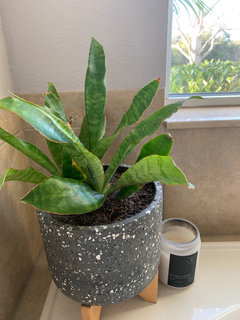
Russ1023 (central Fla)
3 years agolast modified: 3 years agoJamie, that's pretty hard core with the county making your folks get rid of the sansevierias. They're considered a major invasive plant in all of Florida, but I've never heard of such aggressive enforcement.
Do leaves on your sans have a thread-like brown edge, or are they green?
Jamie Reynolds Zone 9b
3 years agoThey’re all brown! They’re on sanibel island so it’s the island calling the shots. They have to have 90% of vegetation be native to the island. Also have some ordinance about your driveways, sidewalks and patios be 80% porous. AND! You can only trim your trees 10% and it has to be approved. They had two really huge strangler palms the size of a 100 year old live oak that they were not allowed to cut down even though it was starting to push up their 2 year old pool. My dad ended up drilling holes in the roots and poured roundup in the holes. According to the island, hurricane Irma killed them haha!
Russ1023 (central Fla)
3 years agolast modified: 3 years agoThere are communities in my area with severe restrictions but not so much on trees and plants. No pickup trucks in the driveway, garage doors can only be open a short number of minutes, no vegetable gardens, even interior paint colors have to be approved.
Brown edges excludes trifasciata, which I thought was a possibility since it was planted in a home landscape. So more than likely you have hyacinthoides, or maybe metallica which used to be called guineensis.
That's amazing they disallowed cutting down the Strangler Figs, which is a ficus with massive roots. Seeds are spread by birds and as far as I know it isn't a native.
Jamie Reynolds Zone 9b
3 years agoMy community has a very strict hoa like you mentioned but yes nothing quite like the island’s restrictions. They didn’t plant these, they were just in their “woods” which was left untouched when they build to add to the total vegetation land cover. They grow like weeds. My dad is pulling them out every 6 months.
Stush2049 Pitts. PA, zone 6
3 years agoYou know, it's just me but if I was going to grow Sans outside, or even inside, I would invest in some thing nicer or more valuable. S. hyacinthoides would be my last choice. But the only Iris I can grow in my yard was a wild one that grew at my Parents house when we first moved in. I grew to love that plant even thou there are many bigger and nice ones out there. But again this one grows good for me. I didn't think that S. hyacinthoides would spread well by seeds and only root rhizomes. So it should never be a problem in private yards? Bamboo grass is one for us here. If grew in a area where it's rhizome roots are constrained it is no problem.
Russ1023 (central Fla)
3 years agolast modified: 3 years agoI agree with you Stush, hyacinthoides and metallica will never be show stoppers and don't even make good trading material. I just have them to keep my collection as complete as possible, I won't reject any sans not in my collection, however any new species is more desirable to me than the pretty variegated varieties so popular now.
Like you I've wondered how hyacinthoides has become such a big problem in Florida. Unless birds or critters eat the fruit containing seeds I don't see how it could be spread so widely, especially to wild areas not frequented by people. I've found Laurentii in woods a few times, but it was obvious people had thrown out plants they didn't want and they rooted and grew. They were always contained within the small area where they started though, and had not spread throughout the woods. Even the hyacinthoides at the beach ramp in Cocoa Beach were contained within a gigantic clump of thousands of plants, and had not spread down the dunes in either direction through seed distribution.
Jamie Reynolds Zone 9b
3 years agoI know their argument on the island for ripping them out is that they are highly toxic to the wildlife. I know they’re very toxic to your pets to so I keep mine up and away from my cat.
Dan
Original Author3 years agolast modified: 3 years agoSitting here in PA in January, is sounds like another planet where you’d have to worry about invasive sans. I can’t wait until I can do a little more traveling again and see some more tropical plants thriving in the wild.
I always wondered if pet owners actually had issues with pets eating toxic plants (unfortunately, no cats or dogs here). Seems like sansevierias are one of the last things I’d want to take a bite out of.
Basia K
3 years agoComing back to original question - Dan, I would definitely wait for new growth. Any sprouting leaf on masoniana has this lovely purple sheath (color fades in time) and this is the easiest way to identify the plant. Having said that much, I think that you do have masoniana; grandis (hyacinthoides?) is much less mottled and its leaves, while huge and fin-like, are somewhat glossy, not matte. Good luck with your plant!
Dan
Original Author3 years agoThanks Basia. I guess time will tell with this one. If grandis has even remotely glossy leaves- this definitely ain’t that. At this point, I think I’d be most excited if it was something else I haven’t considered altogether!
Jamie Reynolds Zone 9b
3 years agoGood morning all! See my attachment, it’s the official notice for removal of the snake plant. They ID it as sansevieria hyacinthoides. Ours look very similar so I think this is the ID for yours too!

Stush2049 Pitts. PA, zone 6
3 years agoDan, I don't think yours is S. hyacinthoides as well. Most likely what you have suggested.
Dan thanked Stush2049 Pitts. PA, zone 6Dan
Original Author3 years ago
Quick photographic update for anyone that was interested in this Sans. Some new growth began popping up a couple weeks ago, and has a distinctly purplish coloration. I love it!
Russ1023 (central Fla)
3 years agolast modified: 3 years agoHey Dan, that purple leaf sheath excludes hyacinthoides and grandis, and confirms your sans is masoniana. The only other sans I know of that have the purple sheath are sulcata, now called bacularis, and dawei. The small unidentified species Lake Sibaya has a purplish-red petiole but is distinctly different from this purple-striped leaf sheath that dries and crumbles away in a short time.
Jamie, your posting of the Sanibel Natural Resources article was interesting, but full of inaccuracies. I'm not convinced any sans is poisonous, I find as many articles saying it's safe as those saying it's mildly toxic to toxic. Hyacinthoides has actually been a medicinal plant in native Africa. I also consider it absolutely ignorant to use toxicity as a reason to call for it's eradication when cities and counties across the state install the deadly oleander by the thousands in their own beautification plantings of roadsides, median strips and buildings. Hundreds of oleanders are planted by the city along Daytona Racetrack in Volusia county.
Hyacinthoides is only slightly invasive compared to the likes of Brazilian Pepper, seeds of which are spread far and wide by birds. The large shrubs form huge thickets everywhere in the landscape. Hyacinthoides stays put and doesn't travel, I've never seen or read of seeds being dispersed by birds or critters. Once an unwanted clump is found, digging up and revisiting the site a few times will eradicate it completely. Not a big deal.
Finally, the term Mother In Law's Tongue has been applied to any of the tall, flat-leaved sansevierias, but it's far more commonly applied to trifasciata than hyacinthoides. I've seen trifasciata Laurentii more often in woods and unoccupied land parcels than hyacinthoides, altho there's a huge patch of thousands of the latter at a beach ramp in Cocoa Beach Fla. I've assumed it was planted decades ago to help with dune erosion.






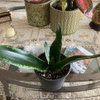

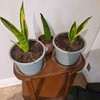
Russ1023 (central Fla)